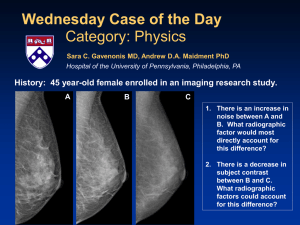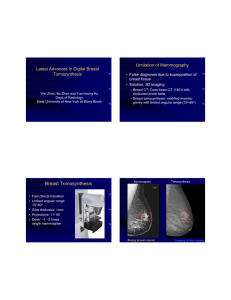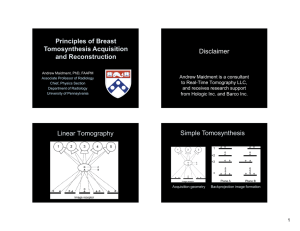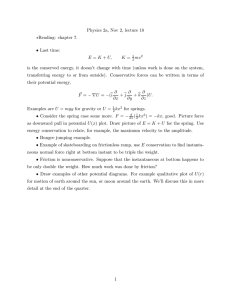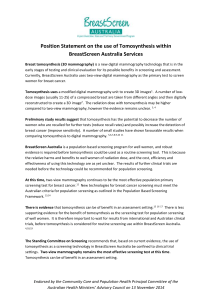Introduction to Tomosynthesis
advertisement
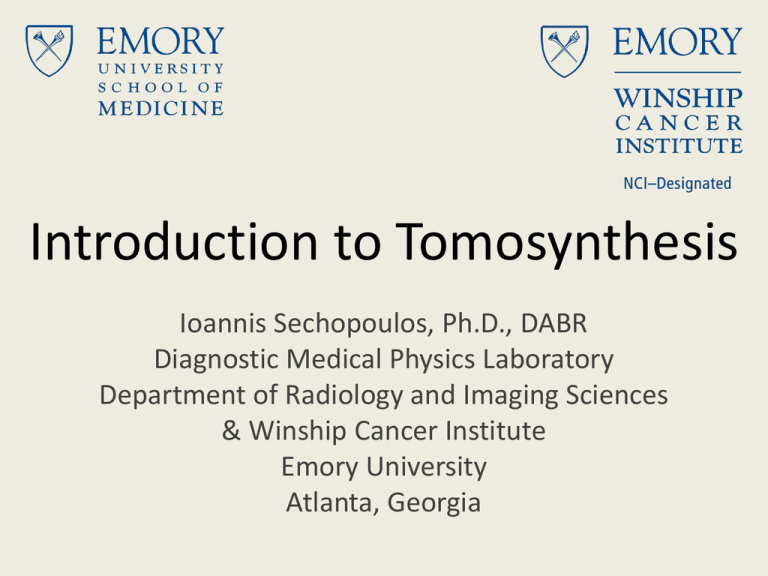
Introduction to Tomosynthesis Ioannis Sechopoulos, Ph.D., DABR Diagnostic Medical Physics Laboratory Department of Radiology and Imaging Sciences & Winship Cancer Institute Emory University Atlanta, Georgia Disclosure • Institutional Research Collaborations: – Barco – Hologic • Consultant: – Fuji Medical Systems USA 2 Learning Objectives • To understand the fundamental principles behind tomosynthesis • To explain the possible different system designs • To explain the determinants of image quality • To list the factors that affect radiation dose • To understand the common artifacts in tomosynthesis 3 Outline Motivation Introduction System Design and Design Considerations Image Reconstruction Radiation Dose X-Ray Scatter Artifacts Synthetic Mammograms 4 MOTIVATION 5 6 7 0.16 lesion localization fraction Vikgren et al, Radiology 249(3), 1034-1041 (2008). 8 Vikgren et al, Radiology 249(3), 1034-1041 (2008). 9 10 11 12 29% of missed cancers were missed due to being “obscured by overlying tissue” Birdwell et al, Radiology 219, 192-202 (2001). 13 14 15 16 Courtesy GE Medical Systems 17 18 Computed Tomography More expensive Higher radiation dose 100x chest CT over chest radiograph 2-5x breast CT over mammography Metal problematic Slower to read (?) ….otherwise, fantastic! 19 Is there a halfway?? (can we get the best of both worlds?) 20 21 Linear Tomography Bushberg et al, The Essential Physics of Medical Imaging, 2nd edition. 22 Towards Tomographic Imaging 2D 2+ D 2.1 D 2.2 D 3D Standard Transmission Imaging Stereoscopic Imaging Linear Tomography Digital Tomosynthesis Computed Tomography (If your optical system can handle it!) (If you plan ahead!) (Is more always better?) 23 DIGITAL TOMOSYNTHESIS 24 Translated X-ray source X-ray beam Lesions of Interest Detector This information is used to reconstruct the volume 25 Shift correlates with vertical location 26 Recall Courtesy of Hologic Inc. 27 CC view .IDC Courtesy of Hologic Inc. 28 Courtesy of Hologic Inc. 29 Benefits Similar to Radiography/Mammography System Workflow Interpretation Dose …but with some discrimination of vertical position! 30 SYSTEM DESIGN AND DESIGN CONSIDERATIONS 31 FFDM System Breast Tomo System 32 Courtesy Joseph Lo (via youtube) 33 https://www.youtube.com/watch?v=g9AjqhQJwAs 34 Courtesy of Philips Digital Mammography AB 35 System Detector Type Detector Motion X-Ray Tube Motion Detector to Center of Rotation Distance (cm) Fuji AMULET GE Essential Innovality Full field Direct (a-Se) Full field (Hexagonal Indirect pixels) Static Static Hologic Selenia Dimensions IMS Giotto TOMO Full field Full field Direct (a-Se) Direct (a-Se) Rotating Static Continuous Step-and-Shoot Continuous Step-and-Shoot Philips MicroDose Planmed Siemens Nuance Excel MAMMOMAT DBT Inspiration Linear Slit Scan – Spectral Full field Full field Photon Direct (a-Se) Direct (a-Se) Counting (Si) Continuous Slit Rotating during Static Scan exposure Continuous Continuous Continuous 4 4 0 2 -40 4.37 4.7 Angular Range Number of Projections Scan Time (sec) 15 25 15 40 11 30 50 15 9 15 13 21 15 25 4 7 3 – 10 20 25 Reconstruction Method Modified FBP Iterative Iterative Iterative FBP Commercial System** Commercial System Prototype Prototype Commercial System Development Stage 12 Iterative with Total Variation FBP Regularization Commercial Commercial System** System 3.7 **Currently not approved for clinical use in the U.S. by the Food and Drug Administration (FDA) 36 http://2014.bhpa.eu/wp-content/uploads/formidable/Marshall_Nicolas.pdf 37 Courtesy of Otto Zhou, Applied Nanotechnology Laboratory, University of North Carolina at Chapel Hill 38 System MTF CNT s-DBT DBT ~30% increase in system resolution for standard 15 degree, 15 view scan A. Tucker, et al, Med Phys 2012 Micro-calcification visibility S-DBT reconstructions above MC # 1 MC # 2 MC # 3 Continuous motion DBT reconstructions MC # 4 MC # 5 MC # 6 Shan et al, Phys. Med. Biol. 60, 81-101, 2015 41 System Detector Type Detector Motion X-Ray Tube Motion Detector to Center of Rotation Distance (cm) Fuji AMULET GE Essential Innovality Full field Direct (a-Se) Full field (Hexagonal Indirect pixels) Static Static Hologic Selenia Dimensions IMS Giotto TOMO Full field Full field Direct (a-Se) Direct (a-Se) Rotating Static Continuous Step-and-Shoot Continuous Step-and-Shoot Philips MicroDose Planmed Siemens Nuance Excel MAMMOMAT DBT Inspiration Linear Slit Scan – Spectral Full field Full field Photon Direct (a-Se) Direct (a-Se) Counting (Si) Continuous Slit Rotating during Static Scan exposure Continuous Continuous Continuous 4 4 0 2 -40 4.37 4.7 Angular Range Number of Projections Scan Time (sec) 15 25 15 40 11 30 50 15 9 15 13 21 15 25 4 7 3 – 10 20 25 Reconstruction Method Modified FBP Iterative Iterative Iterative FBP Commercial System** Commercial System Prototype Prototype Commercial System Development Stage 12 Iterative with Total Variation FBP Regularization Commercial Commercial System** System 3.7 **Currently not approved for clinical use in the U.S. by the Food and Drug Administration (FDA) 42 Total Angular Range Oblique Incidence (20 deg) Acciavatti and Maidment, Medical Physics, 38(11), 2011 43 Oblique Incidence – Direct Detectors Zhao and Zhao, Medical Physics, 35(5), 2008 44 Oblique Incidence – Indirect Detectors Mainprize et al, Medical Physics, 33(9), 2006 45 Acquisition Geometry Radiography: 1 position, 1 shot CT: full revolution, 1000 shots Tomosynthesis: ??? 46 Acquisition Geometry Optimization Acquisition parameters: Angular range Number of projection angles 47 Maidment et al, Proceedings of SPIE, 5745, 2005 48 Artifact Spread Function ASF z = Wu et al, Medical Physics, 31(9), 2004 Is z -IBG z Is z0 -IBG z0 49 Angular Range Hu et al, Medical Physics, 35(12), 2008 50 Image Acquisition Optimization Computer simulated breast volume and lesions 63 different acquisition geometries In-plane quality and vertical resolution 51 (a) Mass Masses: Increased in-plane quality with increased angular range, fewer projections Sechopoulos and Ghetti, Medical Physics 2009, 36, 1199-1207. 52 µCa: Increased in-plane quality with decreased angular range ( mammo), fewer projections (small effect) Sechopoulos and Ghetti, Medical Physics 2009, 36, 1199-1207. 53 Vertical resolution increases with angular range Sechopoulos and Ghetti, Medical Physics 2009, 36, 1199-1207. 54 Threshold number of projections to improve vertical resolution Sechopoulos and Ghetti, Medical Physics 2009, 36, 1199-1207. 55 Acquisition Geometry and Vertical Resolution aSubstantial artifacts due to narrow angular range Sechopoulos and Ghetti, Medical Physics 2009, 36, 1199-1207. 56 Subsequent studies: Threshold number of projections for each angular range was confirmed by others Tucker et al, Proc. SPIE 8313, 831307-831310 (2012) A. S. Chawla et al, Med. Phys. 36, 4859-4869 (2009) I. Reiser and R. M. Nishikawa, Med. Phys. 37, 1591-1600 (2010) Goodsitt et al, Phys. Med. Biol. 59 (2014) 5883 57 Chest Tomosynthesis No gain in increase in projections beyond a certain number Söderman et al, Medical Physics, Vol. 42, No. 3, 2015 58 Acquisition Geometry ↑ angular range ↑ # of projections ↑ vertical resolution ↑ vertical resolution up to a point Have to consider: scan time anatomy detector size 59 ACQUISITION TECHNIQUE 60 Tube Voltage Selection Multiple studies reported higher kV than mammo optimal for tomo Ren et al, Proceedings of SPIE 5745, 550–561 (2005). Zhao et al, Proceedings of SPIE 5745, 1272–1281 (2005). Wu et al, Proceedings of SPIE 6142, 61425E (2006) One study reported lower energies beneficial Glick and Gong, Proceedings of SPIE 6142, 61421L–61429L (2006). 61 Technique and Dosimetric Characterization of a Clinical System Feng and Sechopoulos, Radiology, 2012; 263(3): 35-42 62 Tomosynthesis Mammography Breast Thickness Tube Filter 1st Tube HVL Voltage 1st HVL Filter Voltage (mm Al) (cm) (mm Al) (kVp) (kVp) 2 Al 26 0.441 Rh 25 0.453 3 Al 28 0.476 Rh 26 0.494 4 Al 29 0.490 Rh 28 0.517 5 Al 31 0.541 Rh 29 0.551 6 Al 33 0.572 Rh 31 0.567 7 Al 35 0.600 Ag 30 0.586 8 Al 38 0.660 Ag 32 0.611 Feng and Sechopoulos, Radiology, 2012; 263(3): 35-42 63 TOMOSYNTHESIS RECONSTRUCTION 64 System Detector Type Detector Motion X-Ray Tube Motion Detector to Center of Rotation Distance (cm) Fuji AMULET GE Essential Innovality Full field Direct (a-Se) Full field (Hexagonal Indirect pixels) Static Static Hologic Selenia Dimensions IMS Giotto TOMO Full field Full field Direct (a-Se) Direct (a-Se) Rotating Static Continuous Step-and-Shoot Continuous Step-and-Shoot Philips MicroDose Planmed Siemens Nuance Excel MAMMOMAT DBT Inspiration Linear Slit Scan – Spectral Full field Full field Photon Direct (a-Se) Direct (a-Se) Counting (Si) Continuous Slit Rotating during Static Scan exposure Continuous Continuous Continuous 4 4 0 2 -40 4.37 4.7 Angular Range Number of Projections Scan Time (sec) 15 25 15 40 11 30 50 15 9 15 13 21 15 25 4 7 3 – 10 20 25 Reconstruction Method Modified FBP Iterative Iterative Iterative FBP Commercial System** Commercial System Prototype Prototype Commercial System Development Stage 12 Iterative with Total Variation FBP Regularization Commercial Commercial System** System 3.7 **Currently not approved for clinical use in the U.S. by the Food and Drug Administration (FDA) 65 (really) Filtered Back Projection Hfilter (ωy, ωz) = Hspectrum(ωy) ⋅ Hprofile(ωz) ⋅ Hinverse(ωy, ωz) Hspectrum(ωy): Hanning filter to control noise Hinverse(ωy, ωz): Ramp-type filter Hprofile(ωz): Slice profile filter for constant depth resolution Mertelmeier et al, SPIE 6142, 61420F (2006) 66 Mertelmeier et al, SPIE 6142, 61420F (2006) 67 Mertelmeier et al, SPIE 6142, 61420F (2006) 68 Zhou et al, Medical Physics, Vol. 34, No. 3, March 2007 69 FBP w/ramp only + Hanning & thickness filter + Hanning & thickness filter 2 SBP Iterative + modified ramp Zhou et al, Medical Physics, Vol. 34, No. 3, March 2007 70 Iterative Reconstruction Methods Guess the reconstructed volume Adjust guess vi 1 vi vi lvp E Yp p l vp R E p Simulate the projections that would result from the guessed volume N=N0e-ΣµT Acquired projections Compare Simulated projections of guessed volume 71 Other Reconstruction Methods SIRT SART ART MLEM TVR 72 Van de Sompel et al, Medical Image Analysis 2011, 15, 53–70 73 Comparison of Reconstructions Optimal acquisition might differ for different recons Challenging for a single group to implement and optimize all recons Most appropriate metric(s)? 74 Tomosynthesis Reconstruction Mono-energetic Assumption Or constant spectral beam No explicit definition Same case with CT reconstruction algorithms 75 Standard Tomosynthesis Spectrum 0.06 3.5 W/Al 32 kVp µ = 25.2 keV 3.0 µ Breast Tissue (cm^-1) 2.5 Normalized Spectrum 0.04 µ = 21.7 keV 2.0 0.03 1.5 0.02 1.0 Linear Attenuation Coefficient (cm-1) W/Al 32 kVp + 6 cm of breast tissue 0.05 0.01 0.5 0.00 0.0 0 5 10 15 20 25 30 35 40 X-Ray Energy (keV) 76 Breast Tomosynthesis Acquisition Model bi e x , dl L ,i d biθ acquired signal at pixel i for projection θ ψ(ε) incident energy fluence at energy ε µ(x,ε) linear attenuation coefficient of voxel x at energy ε L θ,i line from source to pixel i for projection θ 77 Breast Tomosynthesis Acquisition Model Minimize Poisson likelihood : X MLE arg min L X L X bi bi log bi Using iterative gradient descent optimization method Sechopoulos et al, European Congress of Radiology, 2013 78 Homogeneous Phantom + Masses FBP 0% 80% 60% 40% 100% MLEM 20% 0% 80% 60% 40% 100% Spectral 20% 0% 80% 60% 40% 20% 100% 79 Homogeneous Phantom + Masses 14 Spectral 12 MLEM 10 FBP SDNR 8 6 4 2 0 0 -2 20 40 60 80 100 Lesion Glandular Density (%) 80 Homogeneous Phantom + Microcalcifications FBP Spectral 81 Homogeneous Phantom + Microcalcifications FBP Spectral 82 RADIATION DOSE 83 Breast Tomosynthesis Dosimetry Model • Mammography: AGDMAMMO Dg NMAMMO AK • Tomosynthesis: AGDTOMO AAPM Task Group Report 234 MAX RGD MIN Dg NMAMMO AK N 84 Relative Glandular Dose 1.2 (a) Glandular fraction 1.0 1.0 0.8 0.8 RGD() RGD() 1.2 0.6 1% 25% 50% 75% 100% 0.4 0.2 (a) (d) X-ray spectrum 0.6 0.2 (b) 0.0 0.0 -30 -20 -10 0 10 20 30 -30 -20 Projection Angle (deg) 1.4 1.2 -10 0 10 20 30 Projection Angle (deg) 1.2 (c) Chest wall to nipple distance (b) Thickness 1.0 1.0 0.8 RGD() RGD() Mo/Mo 25 kVp Mo/Mo 27 kVp Mo/Rh 29 kVp Rh/Rh 31 kVp Rh/Rh 35 kVp 0.4 0.8 0.6 7 cm 10 cm 13 cm 16 cm 19 cm 0.4 0.2 (c) 2 cm 3 cm 4 cm 5 cm 6 cm 7 cm 8 cm 0.6 0.4 0.2 (d) 0.0 0.0 -30 -20 -10 0 10 20 Projection Angle (deg) Sechopoulos et al, Med Phys, 2007; 3(1): 221-232 30 -30 -20 -10 0 10 20 30 Projection Angle (deg) 85 Mammography and Tomosynthesis Dose Feng and Sechopoulos, Radiology, 2012, 263(1): 35-42 86 AGD Ratio of Tomo / Mammo Breast Thickness (cm) 2 3 4 5 6 7 8 Glandular Density (%) 1 2.47 2.40 2.66 2.37 1.91 2.26 2.13 Feng and Sechopoulos, Radiology, 2012, 263(1): 35-42 14.3 2.34 1.94 2.11 1.90 1.83 1.75 1.85 25 1.87 1.49 1.84 1.53 1.94 1.38 1.46 50 1.78 1.39 1.28 1.08 1.25 1.12 1.16 87 Mean AGD [mGy] GE SenoClaire Essential Breast Thickness All <40 mm 41-50 mm 51-60 mm 61-70 mm >70 mm N 236 28 46 74 55 33 Mammo 1.62 1.13 1.34 1.48 1.82 2.39 Paulis et al, Investigative Radiology, online ahead of print Tomo 1.49 1.14 1.33 1.41 1.62 1.98 88 Chest Imaging Effective Dose [mSv] 2-View CXR 0.056 Chest Tomo 0.124 Sabol, Medical Physics, Vol. 36, No. 12, 2009 Chest CT 7 89 Does the exposure distribution have to be uniform? x mAs x mAs x mAs x mAs x mAs X-ray beam Detector 90 How about: x mAs x mAs X-ray beam Detector y mAs x mAs x mAs y<x ? y>x ? 91 Or even: x mAs x mAs X-ray beam Detector y mAs x mAs x mAs y<x ? y>x ? 92 Mammo Tomo Nishikawa, Reiser et al, Proceedings of SPIE 6510, 65103C–65108C (2007). Proposal 93 μCa detectability: center projection < single center slice of reconstruction Mass detectability: no statistically significant difference Das et al, Medical Physics 2009, 36(6), 2009 94 Standard Tomo Variable 7 central / 18 total proj Hu and Zhao, Med. Phys. 38(5), 2455–2466 (2011). Variable 5 central / 20 total proj 95 Uneven distribution of exposure and nonuniform angular sampling used by one commercial manufacturer in systems outside the US. 96 What if?? y kVp x kVp x kVp y kVp x kVp Improved image quality? Dose reduction? Single-pass contrast enhanced imaging? 97 Dual Spectrum Single Pass Tomo 49 kVp + Cu AEC kVp AEC kVp Sechopoulos et al, European Congress of Radiology, 2015 49 kVp + Cu AEC kVp 98 8 cm Homogeneous Phantom + Masses AEC (38 kVp, 84 mAs) Sechopoulos et al, European Congress of Radiology, 2015 AEC + 49 kVp/0.254 mm Cu 99 p = 0.412826 Sechopoulos et al, European Congress of Radiology, 2015 100 p = 0.232631 Sechopoulos et al, European Congress of Radiology, 2015 101 Results Thickness SDNR Difference Dose 5 cm -16.0 ± 9.25% (p>0.08) -48% 8 cm -3.2 ± 19.9% (p>0.41) -28% Sechopoulos et al, European Congress of Radiology, 2015 102 X-RAY SCATTER 103 Effect of Scatter in Tomosynthesis Wu et al, Proc SPIE, 2007 104 How is Scatter Normally Dealt With? Cellular Grid Incident x-rays Imaged object Scattered x-rays Scatter grid Air Radioopaque Material Linear Grid Primary-only x-rays Detector Radio-opaque Material Radiotransparent Material A clinical grid transmits ~80% of primary and ~20% of scatter x-rays 105 Grids in Tomosynthesis Cut-off at higher projection angles Primary photon absorption Prone to image artifacts 106 GE SenoClaire Essential Uses anti-scatter grid for DBT acquisition Septa perpendicular to standard position High number of lines per unit length 107 Alternatives Post-acquisition processing Correction during reconstruction 108 TOMOSYNTHESIS ARTIFACTS 109 High contrast off-plane objects introduce artifacts “Voting” strategy to identify projections in which appropriate information is included, others ignored Especially important for acquisitions with low number of projections Wu et al, Medical Physics. 33(7), 2461–2471 (2006). 110 “Mask” to reconstruct only inside the breast Faster reconstruction Avoids artifacts outside breast Zhang et al, Med. Phys. 34(9), 3603–3613 (2007) 111 Breast tissue outside reconstructed volume but that contributes to attenuation Breast tissue outside wide projection FOV Reconstructed volume Sechopoulos, Medical Physics, Vol. 40, No. 1, 2013 112 Varying number of projections contributes to the volume update, introducing discontinuities: introduced equalization using neighbor values updated by previous projection Bright artifact due to tissue attenuation outside volume: assume extension of “average” breast tissue outside of field of view to avoid bright artifact Zhang et al, J. Comput. Assist. Tomogr. 33(3), 426–435 (2009). 113 Uncorrected Previous Improved Improved estimation of x-ray path length in tissue outside field of view Lu et al, Proceedings of the 11th IWDM 2012, pp. 745–752. 114 SYNTHETIC MAMMOGRAMS 115 Mammogram Orig. Synthetic Gur et al, Academic Radiology, Vol 19, No 2, 2012 Tomo Slice 116 Recall Rates DBT + FFDM DBT + Synthetic False Positive Rate % Detected Cancers False Positive Rate % Detected Cancers 1st Generation 53.1 83.5 46.1 77.7 2nd Generation 45.6 87.3 45.2 85.5 Skaane et al, Radiology, Vol 271(3), 2014 117 Synthetic Mammograms Included in various commercial systems 118 Current Research CADe and CADx for tomosynthesis Need to lower reading time Contrast enhanced tomosynthesis Phase contrast tomosynthesis Tomosynthesis elastography 119 Multimodality Imaging Tomosynthesis + US + SPECT + Electrical Impedance + Optical 120 Summary Fast digital detectors Advanced imaging Need to lower anatomic noise Tomosynthesis similar to planar radiography System footprint Workflow Image interpretation 121 Summary Acquisition geometry large impact on image quality Dosimetry > but similar to planar radiography Ongoing research in: Reconstruction algorithms Other techniques (enhanced, phase, etc.) Multimodality 122 QUESTIONS 123 In terms of image acquisition, what is the main difference between linear tomography and digital tomosynthesis? 1. 2. 3. 4. Linear tomography acquisition takes substantially longer than digital tomosynthesis. Linear tomography results in a single plane being in focus per acquisition while in digital tomosynthesis any number of planes can be reconstructed to be in focus. Linear tomography results in circular images while digital tomosynthesis results in rectangular images. In linear tomography the x-ray tube moves in a straight line while in digital tomosynthesis it moves in a circle. 75% 13% 13% 0% 1. 2. 3. 4. In terms of image acquisition, what is the main difference between linear tomography and digital tomosynthesis? (2) In linear tomography, the in-focus plane has to be selected before acquisition, while in digital tomosynthesis, the reconstruction of the acquired projections results in many planes being in focus. Bushberg et al, “The Essential Physics of Medical Imaging”, 3rd Edition 125 How does increasing the angular range of the tomosynthesis scan affect the vertical resolution of the reconstructed image? 1. Consistently decreases 2. Decreases up to a point, then remains constant 3. Vertical resolution does not increase with increasing angular range 4. Increases up to a point, then remains constant 5. Consistently increases 50% 50% 0% 1. 2. 3. 0% 0% 4. 5. How does increasing the angular range of the tomosynthesis scan affect the vertical resolution of the reconstructed image? (5) Increasing the angular range covered by the swing of the x-ray source consistently increases the vertical resolution of the reconstructed tomosynthesis image. Sechopoulos and Ghetti, Medical Physics 2009, 36, 1199-1207. 127 How does increasing the number of projections of the tomosynthesis scan affect the vertical resolution of the reconstructed image? 1. Consistently decreases 2. Decreases up to a point, then remains constant 3. Vertical resolution does not increase with increasing number of projections 4. Increases up to a point, then remains constant 5. Consistently increases 0% 1. 0% 0% 2. 3. 0% 0% 4. 5. 10 How does increasing the number of projections of the tomosynthesis scan affect the vertical resolution of the reconstructed image? (4) Increasing the number of projections during a tomosynthesis acquisition increases the vertical resolution up to a certain threshold, beyond which the resolution remains constant unless the angular range is increased. Sechopoulos and Ghetti, Medical Physics 2009, 36, 1199-1207. 129 Why is there a high interest in chest tomosynthesis? 0% 0% 0% 0% 0% 1. Much lower dose than chest radiography with out-of-plane blurring 2. Much lower dose than chest CT with outof-plane blurring 3. Same vertical resolution as chest CT but lower dose 4. Improved vertical resolution as chest CT at same dose 5. Same vertical resolution and dose as chest CT, but considerably cheaper 10 Why is there a high interest in chest tomosynthesis? (2) Chest tomosynthesis involves, in general, higher dose than chest radiography, but considerably lower than chest CT. Although it doesn’t result in true tomographic images as chest CT, it provides enough vertical resolution to be superior to chest radiography and sufficient for some clinical applications. Sabol, Medical Physics, Vol. 36, No. 12, 2009 Dobbins and McAdams, European Journal of Radiology 72 (2009) 244–251 131 Introduction to Tomosynthesis Ioannis Sechopoulos, Ph.D., DABR Diagnostic Medical Physics Laboratory Department of Radiology and Imaging Sciences & Winship Cancer Institute Emory University Atlanta, Georgia
